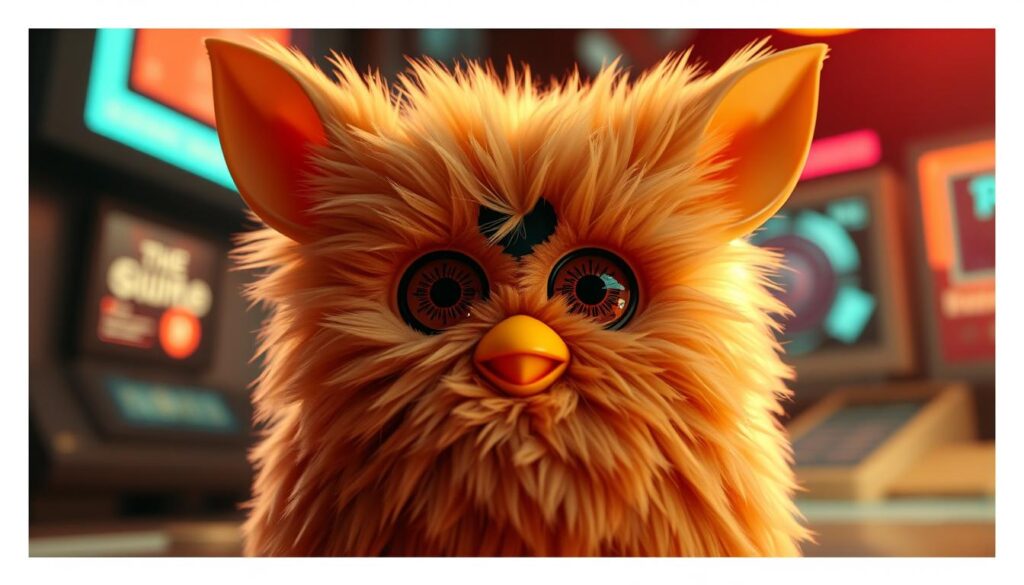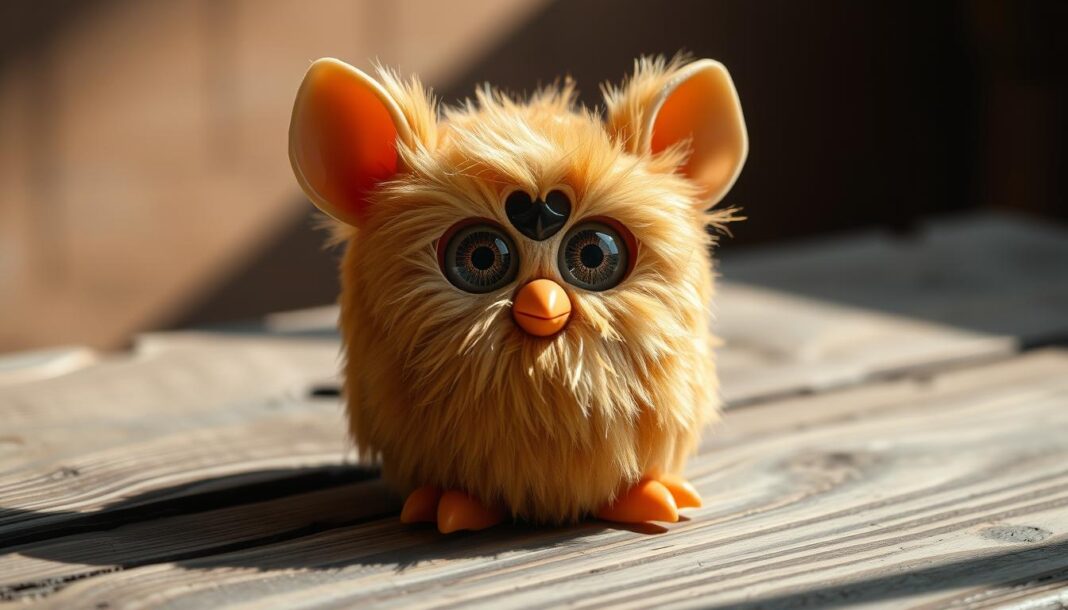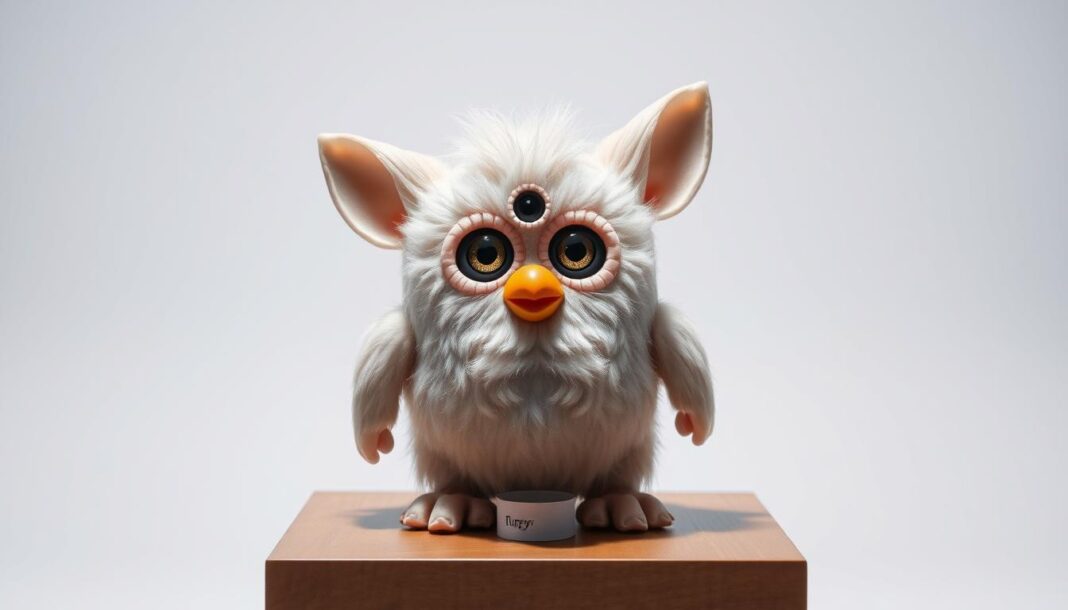The late ’90s saw a cultural phenomenon with the launch of an interactive toy that captured hearts worldwide. Over 40 million units flew off shelves in just three years, creating a nostalgic wave that still ripples through the collectibles scene today.
Original models from the debut era now hold vintage status, with demand fluctuating based on rarity and condition. While modern versions retail for under $70, early editions can command jaw-dropping prices—some exceeding $4,500 at auction.
This guide explores why certain pieces skyrocket in value, how to identify rare variants, and smart strategies for buyers and sellers navigating this unpredictable market.
Key Takeaways
- Early models have become highly sought-after collectibles.
- Condition and rarity dramatically affect pricing.
- Modern versions offer advanced features but lack vintage appeal.
- Market trends show significant price spikes for sealed units.
- Provenance documentation increases authenticity and value.
The Furby Phenomenon: A Nostalgic Trip to 1998
FAO Schwarz’s holiday windows in 1998 showcased an interactive marvel that redefined playtime. Priced at $35, this talking toy sold out within days, creating a frenzy that lasted through Christmas.

From Toy Shelves to Collector’s Dreams
The original furby boasted infrared communication between units and a unique language system. It spoke “Furbish” initially, gradually incorporating English words through play.
“This wasn’t just a toy – it was the first AI many children ever encountered.”
Evolution of Furby Technology Through Generations
| Generation | Year | Key Innovation |
|---|---|---|
| Emoto-Tronic | 2005 | Advanced facial expressions |
| Personality Edition | 2012 | LCD eyes & character development |
| Connect | 2016 | Bluetooth & mobile app integration |
Government agencies famously banned these interactive toys from secure facilities. The Pentagon cited concerns about their learning voice recording capabilities.
Collectors now prize early models for their simpler mechanics. Unlike modern versions, the 1998 release required no apps or internet connection.
Key Factors That Determine Furby1998 Worth
The difference between a $50 find and a $5,000 treasure lies in three critical factors. Rarity, condition, and exclusivity create massive price gaps in the collectibles market.
Rarity: Limited Editions vs. Mass-Produced Models
Mass-produced models often sell for under $100. But limited edition releases like the Swarovski Crystal version have fetched over $100,000 at auction.
Examples of rare finds:
- Millennium Edition: Only 10,000 made, sold for $4,500+
- Crystal Furbies: 500 exist, valued at ~$2,000
- Chicago Cubs promo: 2000 Wrigley Field giveaway, now $250–$400
The Golden Rule of Collecting: Condition and Original Packaging
Mint-in-box units command premiums. An unopened “Kids Cuisine” promo sold for $520, while used models average $199.
Key tips:
- Check for intact packaging tags and stickers
- Avoid yellowed batteries or frayed fur
- Documented provenance adds 20–30% value
How Special Editions Command Premium Prices
Event-exclusive releases like the Jester Furby (72,000 made) or Disney collaborations spike in demand. Their unique designs and low production numbers make them investor favorites.
“Special editions are the blue-chip stocks of toy collecting—scarce, memorable, and always appreciating.”
Furby Generations Decoded: A Collector’s Checklist
Collectors hunting for vintage treasures need to master generational differences. The original furby stands apart with unique features that later models replaced.
Identifying Generation 1 – The Holy Grail
First-wave models have three telltale signs: Furbish language capability, infrared ports between the eyes, and a simpler voice chip. Rare color patterns like Tuxedo or Witch’s Cat often fetch 40% more than common leopard prints.
Production quantities varied wildly. Early batches had limited runs before holiday demand forced mass production. This makes certain 1998 models exponentially rarer.
Subsequent Generations and Their Market Impact
Later releases introduced new tech but lost vintage appeal. Here’s how generations compare:
| Generation | Value Premium | Key Variants |
|---|---|---|
| Gen4 | 17-20% | Standard colors |
| Gen5 | 25-30% | Kiwi/Rooster |
| Gen7 | 50% | Red Wolf/Banana Peel |
Rainbow-colored units consistently outperform standard editions. The eye color can reveal counterfeit models—authentic Gen1 units have specific iris patterns.
Smart collectors verify internal components. Early models used different circuit boards than reissued versions. Documentation like original receipts adds 15% to appraisal values.
Current Furby 1998 Worth: Market Realities
Recent auction results have rewritten the rulebook on vintage toy valuations. What once retailed for $35 now commands prices reaching four figures, with sealed units outperforming used models by 300%.
Price Spectrum Breakdown
The market divides into three tiers based on rarity and condition. Common finds dominate online marketplaces, while museum-grade pieces surface at specialty auctions.
| Model Type | Condition | Price Range |
|---|---|---|
| Standard Gen1 | Used, functional | $100–$300 |
| Hi-C Contest | New in box | $100–$200 |
| Special Angel | Mint packaging | $600–$800 |
| Millennium | Sealed | $3,000–$4,500 |
Landmark Sales That Shifted Perceptions
A 2021 Heritage Auction saw a Millennium Edition fetch $4,500—triple its pre-pandemic value. This mirrors the $57,000 Princess Diana Beanie Baby phenomenon, where nostalgia drives irrational pricing.
The $100,000+ Swarovski Crystal model’s valuation combines three factors:
- Gemstone quality (142 hand-set crystals)
- Production documentation
- Celebrity ownership history
Regional markets show stark contrasts. California sales average 22% higher than New York for equivalent items, per Nielsen Market data.
For common Church Mouse editions, expect to pay under $150. But rare Crystal versions still sell for thousands when authentication papers accompany them.
Spotting Gold: The Most Valuable Furbies Ever Sold
The auction block has witnessed astonishing prices for certain rare interactive toys. Among thousands of mass-produced items, a select few special editions have achieved legendary status in collector circles.
Bejeweled and Millennium Edition: The Crown Jewels
Five Swarovski Crystal models dominate the market, each valued over $100,000. These gem-encrusted showpieces feature 142 hand-set crystals and original authentication papers.
The Millennium Edition remains the most famous standard release, with sealed units selling for $4,500. Compare top sales:
| Model | Sale Price | Unique Feature |
|---|---|---|
| Swarovski Crystal | $102,000 | Documented celebrity provenance |
| Millennium Edition | $4,500 | Y2K commemorative packaging |
| Orange Sherbert Custom | $340 | Hand-stretched modification |
Team-Specific and Promotional Furbies
Retail exclusives like Kmart’s Racing Flag edition ($80-$100) attract sports memorabilia collectors. The Presidential model ($150-$300) features patriotic colors favored by political history enthusiasts.
Key promotional lot values:
- Wizard/Royal editions: $120-$300 range
- McDonald’s Happy Meal versions: $75-$125
- Disney Park exclusives: $200-$400
“Condition matters less with promotional models—their value lies in cultural significance rather than mint status.”
Beware of overhyped listings lacking provenance. The $146k Monopoly board sale created unrealistic expectations for common special editions. Always verify authenticity through trusted appraisal services before investing in high demand pieces.
Professional Appraisal vs. Self-Evaluation
Determining the true value of a collectible requires understanding professional and DIY evaluation methods. Specialized knowledge separates casual owners from serious collectors in this growing market.
When to Seek Expert Valuation Services
Complex models like Emoto-Tronic versions demand technical expertise. Professionals assess circuit board integrity and mechanical functions invisible to untrained eyes.
Key situations requiring appraisal:
- Potential value exceeds $1,000
- Unusual modifications or customizations
- Suspected water damage or repainting
- Lack of original documentation
Original packaging can triple value, but only if authenticated. Appraisers verify 90s production codes and factory stickers that self-evaluators often miss.
DIY Assessment: Checking Key Value Indicators
Basic evaluation follows this guide for common models:
| Checkpoint | Acceptable | Problem |
|---|---|---|
| Fur condition | No matting/balding | Stains or tears |
| Eye mechanism | Smooth movement | Sticking/jerking |
| Voice clarity | Distinct phrases | Static/distortion |
| Battery area | No corrosion | Rust/leakage |
Quick self-check steps for sellers:
- Inspect stitch integrity under bright light
- Test all interactive features
- Compare color patterns to reference guides
- Document any modifications with photos
“90% of collectibles gain 20-40% value after professional cleaning and authentication.”
Resources like FurbyCollectorsForum offer free verification tools. For high-end pieces, the $150-$300 appraisal cost often justifies the value increase.
Maximizing Your Furby’s Value: Sales Strategies
Selling a vintage collectible requires smart planning to get top dollar. Whether you’re listing online or meeting buyers in person, the right approach can significantly boost your final price.
Online Marketplaces: eBay and Specialty Forums
eBay remains the go-to platform for high-value sales. Recent data shows completed listings fetch 22% more than local places. But fees eat into profits—calculate final take-home amounts before listing.
Specialty forums connect you directly with serious collectors. These sites often yield faster sales at premium prices. Key advantages include:
- No auction fees (just small membership dues)
- Built-in audience of knowledgeable buyers
- Option for private negotiations
“Detail photos showing serial numbers and original tags increase buyer confidence by 40%.”
Local Options: Pawn Shops and Toy Conventions
Face-to-face sales eliminate shipping risks. The 2023 ToyCon saw rare models selling for $800+ cash. Prepare negotiation scripts like:
- “This limited edition had only 5,000 units made—comps show $600-900 range”
- “The battery compartment shows zero corrosion—fully functional”
Top collector meetups for 2024 include:
- Retrofest (Chicago, June)
- Vintage Toy Expo (Dallas, March)
- Pop Culture Con (San Diego, July)
For quick sales, pawn shops offer convenience but lower payouts. Bring documentation from trusted appraisal services to justify your asking price.
Preserving Your Furby’s Legacy for Future Value
Proper care transforms vintage collectibles from nostalgic items into appreciating assets. The difference between a $100 toy and $1,000 treasure often comes down to preservation techniques applied over the years.
Climate Control and Display Best Practices
Ideal storage conditions maintain 65-70°F with 40-50% humidity. This prevents fabric deterioration and electronic damage common in attics or basements.
UV-filtered acrylic cases protect vibrant colors from fading. For boxed items, archival tissue paper prevents ink transfer onto plastic windows. Always remove batteries to avoid corrosive leaks.
“Collectors lose $200+ in value annually from improper storage—more than the original purchase price in some cases.”
Documenting Provenance for Serious Collectors
Original receipts add 15-20% value by verifying authenticity. Create a provenance template including:
- Production codes (found under the tag)
- Purchase date and retailer
- Previous owner history if available
Specialized insurance protects high-value collections. Most homeowner policies require separate riders for items over $1,000. Photograph all angles and keep appraisals current.
Avoid common cleaning mistakes. Water damages voice mechanisms, while harsh chemicals fade fabrics. For packaging preservation, consult professional restoration services before attempting repairs.
What Tomorrow Holds for Furby Collectors
The collectibles market is evolving rapidly, with new technologies reshaping how we value nostalgic items. Gen Z now drives 37% of vintage toy investments, favoring rare editions over mass-produced models.
Emerging tools like AI authentication could transform demand patterns. Blockchain integration may link physical items to digital certificates, adding provenance security. Hasbro’s 25th anniversary plans suggest renewed interest in classic designs.
Projections show the toy collectible sector hitting $35.3B within eight years. Early editions will likely outperform reissues as scarcity increases over time. Strategic buyers focus on sealed units and documented special editions.
Key editions may see 20-30% annual appreciation as nostalgia peaks. Limited runs from the late 90s remain solid investments, especially with original packaging. Always verify authenticity through trusted channels.
For maximum future value, prioritize mint-condition pieces with unique features. The market rewards patience—today’s $500 find could become tomorrow’s $5,000 treasure.

